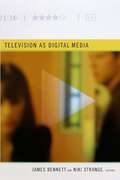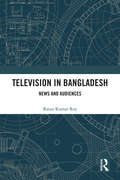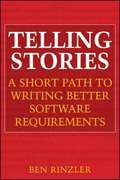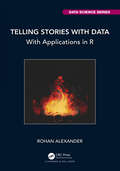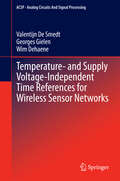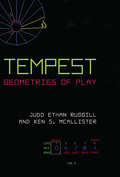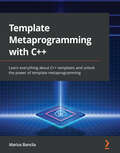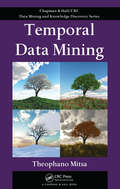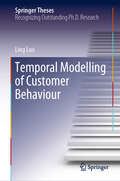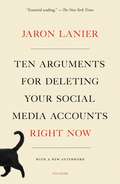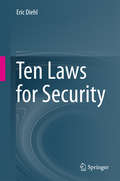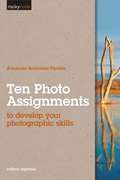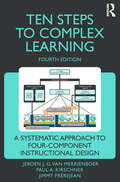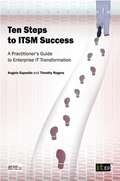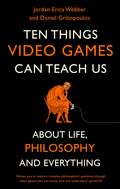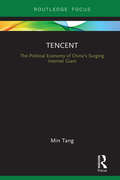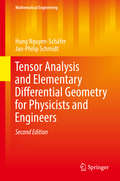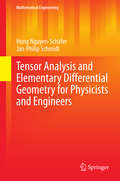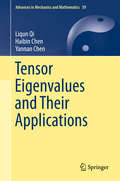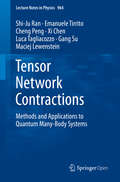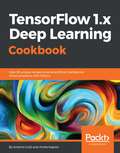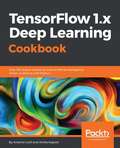- Table View
- List View
Television as Digital Media
by James Bennett Niki StrangeIn Television as Digital Media, scholars from Australia, the United Kingdom, and the United States combine television studies with new media studies to analyze digital TV as part of digital culture. Taking into account technologies, industries, economies, aesthetics, and various production, user, and audience practices, the contributors develop a new critical paradigm for thinking about television, and the future of television studies, in the digital era. The collection brings together established and emerging scholars, producing an intergenerational dialogue that will be useful for anyone seeking to understand the relationship between television and digital media. Introducing the collection, James Bennett explains how television as digital media is a non-site-specific, hybrid cultural and technological form that spreads across platforms such as mobile phones, games consoles, iPods, and online video services, including YouTube, Hulu and the BBC's iPlayer. Television as digital media threatens to upset assumptions about television as a mass medium that has helped define the social collective experience, the organization of everyday life, and forms of sociality. As often as we are promised the convenience of the television experience "anytime, anywhere," we are invited to participate in communities, share television moments, and watch events live. The essays in this collection demonstrate the historical, production, aesthetic, and audience changes and continuities that underpin the emerging meaning of television as digital media. Contributors. James Bennett, William Boddy, Jean Burgess, John Caldwell, Daniel Chamberlain, Max Dawson, Jason Jacobs, Karen Lury, Roberta Pearson, Jeanette Steemers, Niki Strange, Julian Thomas, Graeme Turner
Television in Bangladesh: News and Audiences
by Ratan Kumar RoyThis book examines the role of 24/7 television news channels in Bangladesh. By using a multi-sited ethnography of television news media, it showcases the socio-political undercurrents of media practices and the everydayness of TV news in Bangladesh. It discusses a wide gamut of issues such as news making; localised public sphere; audience reaction and viewing culture; impact of rumours and fake news; socio-political conditions; protest mobilization; newsroom politics and perspectives from the ground. An important intervention in the subject, this book will be useful to scholars and researchers of media studies, journalism and mass communication, anthropology, cultural studies, political sociology, political science, sociology, South Asian studies, as well as television professionals, journalists, civil society activists, and those interested in the study of Bangladesh.
Telling Stories
by Ben RinzlerFrom System Designers to Top Management, Everyone loves a good story Once upon a time, it was well understood that stories teach better than plain facts. Why then are most software requirements documents a baffling hodge-podge of diagrams, data dictionaries, and bullet points, held together by little more than a name and a staple? Telling Stories teaches you to combine proven standards of requirements analysis with the most ancient and effective tool for sharing information, the narrative. Telling Stories simplifies and refines the classic methods of Structured Analysis, providing organization, design, and old-fashioned writing advice. Whether you?re just getting started or an experienced requirements writer, Telling Stories can help you turn dull, detailed material into an engaging, logical, and readable story, a story that can make the difference for your project and your career. Learn why readers believe and remember what they learn from stories Work with team members to gather content, tell their stories, and win their support Use stories to find every requirement Create diagrams that almost tell the story on their own (while looking clear and professional) Explain everything important about a process Use precise language to remove the ambiguity from requirements Write a forceful executive summary that stands on its own and sells a project to senior management Summarize often to keep the reader focused on key issues Structure the document so every part has a clear place and purpose
Telling Stories with Data: With Applications in R (Chapman & Hall/CRC Data Science Series)
by Rohan AlexanderThe book equips students with the end-to-end skills needed to do data science. That means gathering, cleaning, preparing, and sharing data, then using statistical models to analyse data, writing about the results of those models, drawing conclusions from them, and finally, using the cloud to put a model into production, all done in a reproducible way. At the moment, there are a lot of books that teach data science, but most of them assume that you already have the data. This book fills that gap by detailing how to go about gathering datasets, cleaning and preparing them, before analysing them. There are also a lot of books that teach statistical modelling, but few of them teach how to communicate the results of the models and how they help us learn about the world. Very few data science textbooks cover ethics, and most of those that do, have a token ethics chapter. Finally, reproducibility is not often emphasised in data science books. This book is based around a straight-forward workflow conducted in an ethical and reproducible way: gather data, prepare data, analyse data, and communicate those findings. This book will achieve the goals by working through extensive case studies in terms of gathering and preparing data, and integrating ethics throughout. It is specifically designed around teaching how to write about the data and models, so aspects such as writing are explicitly covered. And finally, the use of GitHub and the open-source statistical language R are built in throughout the book. Key Features: Extensive code examples. Ethics integrated throughout. Reproducibility integrated throughout. Focus on data gathering, messy data, and cleaning data. Extensive formative assessment throughout.
Temperature- and Supply Voltage-Independent Time References for Wireless Sensor Networks
by Wim Dehaene Georges Gielen Valentijn De SmedtThis book investigates the possible circuit solutions to overcome the temperature and supply voltage-sensitivity of fully-integrated time references for ultra-low-power communication in wireless sensor networks. The authors provide an elaborate theoretical introduction and literature study to enable full understanding of the design challenges and shortcomings of current oscillator implementations. Furthermore, a closer look to the short-term as well as the long-term frequency stability of integrated oscillators is taken. Next, a design strategy is developed and applied to 5 different oscillator topologies and 1 sensor interface. All 6 implementations are subject to an elaborate study of frequency stability, phase noise and power consumption. In the final chapter all blocks are compared to the state of the art.
Tempest: Geometries Of Play
by Judd Ethan Ruggill Ken S. McallisterAtari's 1981 arcade hit Tempest was a "tube shooter" built around glowing, vector-based geometric shapes. Among its many important contributions to both game and cultural history, Tempest was one of the first commercial titles to allow players to choose the game's initial play difficulty (a system Atari dubbed "SkillStep"), a feature that has since became standard for games of all types. Tempest was also one of the most aesthetically impactful games of the twentieth century, lending its crisp, vector aesthetic to many subsequent movies, television shows, and video games. In this book, Ruggill and McAllister enumerate and analyze Tempest's landmark qualities, exploring the game's aesthetics, development context, and connections to and impact on video game history and culture. By describing the game in technical, historical, and ludic detail, they unpack the game's latent and manifest audio-visual iconography and the ideological meanings this iconography evokes.
Template Metaprogramming with C++: Learn everything about C++ templates and unlock the power of template metaprogramming
by Marius BancilaUnderstand how to use modern C++ templates for writing maintainable, robust, and fast softwareKey FeaturesGrasp the fundamentals of and learn to write effective C++ templatesGet up to speed with the latest C++20 template features such as constraints and conceptsExplore different patterns and idioms to integrate templates in your program designBook DescriptionLearn how the metaprogramming technique enables you to create data structures and functions that allow computation to happen at compile time. With this book, you'll realize how templates help you avoid writing duplicate code and are key to creating generic libraries, such as the standard library or Boost, that can be used in a multitude of programs. The introductory chapters of this book will give you insights into the fundamentals of templates and metaprogramming. You'll then move on to practice writing complex templates and exploring advanced concepts such as template recursion, template argument deduction, forwarding references, type traits, and conditional compilation. Along the way, you'll learn how to write variadic templates and how to provide requirements to the template arguments with C++20 constraints and concepts. Finally, you'll apply your knowledge of C++ metaprogramming templates to implement various metaprogramming patterns and techniques. By the end of this book, you'll have learned how to write effective templates and implement metaprogramming in your everyday programming journey.What you will learnUnderstand the syntax for all types of templatesDiscover how specialization and instantiation worksGet to grips with template argument deduction and forwarding referencesWrite variadic templates with easeBecome familiar with type traits and conditional compilationRestrict template arguments in C++20 with constraints and conceptsImplement patterns such as CRTP, mixins, and tag dispatchingWho this book is forThis book is for beginner-to-intermediate C++ developers who want to learn about template metaprogramming as well as advanced C++ developers looking to get up to speed with the new C++20 features related to templates and the the various idioms and patterns. Basic C++ coding experience is necessary to get started with this book.
Temporal Data Mining
by Theophano MitsaFrom basic data mining concepts to state-of-the-art advances, this book covers the theory of the subject as well as its application in a variety of fields. It discusses the incorporation of temporality in databases as well as temporal data representation, similarity computation, data classification, clustering, pattern discovery, and prediction. The book also explores the use of temporal data mining in medicine and biomedical informatics, business and industrial applications, web usage mining, and spatiotemporal data mining. Along with various state-of-the-art algorithms, each chapter includes detailed references and short descriptions of relevant algorithms and techniques described in other references.
Temporal Logics in Computer Science
by Stéphane Demri Valentin Goranko Martin LangeThis comprehensive text provides a modern and technically precise exposition of the fundamental theory and applications of temporal logics in computer science. Part I presents the basics of discrete transition systems, including constructions and behavioural equivalences. Part II examines the most important temporal logics for transition systems and Part III looks at their expressiveness and complexity. Finally, Part IV describes the main computational methods and decision procedures for model checking and model building - based on tableaux, automata and games - and discusses their relationships. The book contains a wealth of examples and exercises, as well as an extensive annotated bibliography. Thus, the book is not only a solid professional reference for researchers in the field but also a comprehensive graduate textbook that can be used for self-study as well as for teaching courses.
Temporal Modelling of Customer Behaviour (Springer Theses)
by Ling LuoThis book describes advanced machine learning models – such as temporal collaborative filtering, stochastic models and Bayesian nonparametrics – for analysing customer behaviour. It shows how they are used to track changes in customer behaviour, monitor the evolution of customer groups, and detect various factors, such as seasonal effects and preference drifts, that may influence customers’ purchasing behaviour. In addition, the book presents four case studies conducted with data from a supermarket health program in which the customers were segmented and the impact of promotional activities on different segments was evaluated. The outcomes confirm that the models developed here can be used to effectively analyse dynamic behaviour and increase customer engagement. Importantly, the methods introduced here can also be used to analyse other types of behavioural data such as activities on social networks, and educational systems.
Temporal and Spatial Environmental Impact of the COVID-19 Pandemic (Advances in Geographical and Environmental Sciences)
by Mohd Akhter Ali M. KamrajuThis book identifies, evaluates and reports the impacts of the COVID-19 pandemic on the physical, biological and socioeconomic environment, using the science and technology of geoinformatics. It encourages the environmental considerations in the future city and policy planning and decision-making. For example, according to the World Health Organization, 80% of people living in cities are exposed to polluted air that exceeds healthy levels. City planners have applied the developing concepts of sustainability to modern debates over how cities and regions should be reviewed, regenerated and reformed since the introduction of the concept in developmental science. During the COVID-19 pandemic, a remarkable drop in air pollution has been observed in India and other countries, which has accelerated the shift to green and sustainable development. Geoinformatics can provide solutions and resources for local, sustainable activities in education, health, sustainable agriculture, resource management and related fields. This book serves researchers in a variety of areas, including hazards, land surveys, remote sensing, cartography, geophysics, geology, natural resources, environment and geography.
Ten Arguments for Deleting Your Social Media Accounts Right Now
by Jaron LanierA timely call-to-arms from a Silicon Valley pioneer. <p><p>You might have trouble imagining life without your social media accounts, but virtual reality pioneer Jaron Lanier insists that we’re better off without them. In Ten Arguments for Deleting Your Social Media Accounts Right Now, Lanier, who participates in no social media, offers powerful and personal reasons for all of us to leave these dangerous online platforms. <p>Lanier’s reasons for freeing ourselves from social media’s poisonous grip include its tendency to bring out the worst in us, to make politics terrifying, to trick us with illusions of popularity and success, to twist our relationship with the truth, to disconnect us from other people even as we are more “connected” than ever, to rob us of our free will with relentless targeted ads. <p> How can we remain autonomous in a world where we are under continual surveillance and are constantly being prodded by algorithms run by some of the richest corporations in history that have no way of making money other than being paid to manipulate our behavior? How could the benefits of social media possibly outweigh the catastrophic losses to our personal dignity, happiness, and freedom? <p>Lanier remains a tech optimist, so while demonstrating the evil that rules social media business models today, he also envisions a humanistic setting for social networking that can direct us toward a richer and fuller way of living and connecting with our world.
Ten Laws for Security
by Eric DiehlIn this book the author presents the key laws governing information security. He addresses topics such as attacks, vulnerabilities, threats, designing security, identifying key IP assets, authentication, and social engineering. The informal style draws on his experience in the area of video protection and DRM, while the text is supplemented with introductions to the core formal technical ideas. It will be of interest to professionals and researchers engaged with information security.
Ten Photo Assignments
by Amanda Quintenz-FiedlerBecome a Better Digital Photographer, One Assignment at a Time There is no better way to learn than by doing. While theories, histories, best practices, and sciences ground a thorough knowledge of any subject, at some point you have to apply that information to truly garner knowledge. This book provides real-world assignments that guide prospective photographers to a true understanding and mastery of the craft. Each assignment includes a list of goals, detailed instructions, illustrations, and examples. Individual assignments build on one another, allowing your mastery to grow as the book continues. Learn about the capabilities and limitations of your equipment; the proper ways to expose a scene for digital capture; dos and don'ts of cropping and scene placement; how to color manage a scene in-camera; and how to see, manipulate, and augment light to obtain the best possible native files.
Ten Steps to Complex Learning: A Systematic Approach to Four-Component Instructional Design
by Jeroen J. van Merriënboer Paul A. Kirschner Jimmy FrèrejeanTen Steps to Complex Learning presents a path from an educational problem to a solution in a way that students, design practitioners, and researchers can understand and easily use. Students in the fields of instructional design and the learning sciences can use this book to broaden their knowledge of the design of training programs for complex learning. Practitioners can use this book as a reference guide to support their design of courses, curricula, or environments for complex learning.Driven by the acclaimed Four-Component Instructional Design (4C/ID) model, this fourth edition of Ten Steps to Complex Learning is fully revised with the latest research, featuring over 50 new references. The entire book has been updated for clarity, incorporating new colorful graphics and diagrams, and the guiding example used throughout the book is replaced with a training blueprint for the complex skill of “producing video content.” The closing chapter explores the future development of the Ten Steps, discussing changes in teacher roles and the influence of artificial intelligence.
Ten Steps to ITSM Success
by Angelo Esposito Timothy RogersYou've read the books, but... A wealth of material has been written to describe the underlying mechanics of ITSM, but very little practical advice is available on how to implement ITSM best practices to achieve an organization's business objectives. The official ITIL® volumes explain what service management is, how the processes work and fit together, and why IT shops should adopt the practice, but they are notoriously vague on how to design and implement an ITSM model in a real organization. This challenge is best understood by those with experience of transforming ineffective and expensive IT, yet most ITSM guides are authored from a purely academic standpoint. From the classroom to the real world This book provides guidance on implementing ITSM Best Practices in an organization based on the authors' real-world experiences. Advice is delivered through a Ten-Step approach, with each step building upon the successes of its predecessors. Subjects covered include - • Documenting objectives, identifying current and future demands, analyzing service financials. • High-level design, negotiating development priorities, creating an execution plan and roadmap, agreeing roles and responsibilities. • Detailed design, building, testing, deploying. • Monitoring and continual improvement. Each step includes summary lists of key questions to ask and specific actions to take, and a useful business case template is included as an appendix. A practical guide to ITSM Improvement As organizations seek to boost revenue, cut costs and increase efficiency, they increasingly look to IT as a strategic partner in achieving these objectives. Ten Steps to ITSM Success helps IT to prepare for this role by providing a detailed and practical guide to implementing ITSM best practices. It is aimed at ITSM practitioners and consultants, but will also be of interest to IT Directors and C-suite executives looking to transform the role of IT into a value-creating business partner, to establish a service management culture, and to drive improvements in their respective organizations. A structured yet flexible method for achieving ITSM success!
Ten Things Video Games Can Teach Us: (about life, philosophy and everything)
by Jordan Erica Webber Daniel GriliopoulosWOULD YOU KILL ONE PERSON TO SAVE FIVE OTHERS?If you could upload all of your memories into a machine, would that machine be you? Is it possible we're all already artificial intelligences, living inside a simulation?These sound like questions from a philosophy class, but in fact they're from modern, popular video games. Philosophical discussion often uses thought experiments to consider ideas that we can't test in real life, and media like books, films, and games can make these thought experiments far more accessible to a non-academic audience. Thanks to their interactive nature, video games can be especially effective ways to explore these ideas.Each chapter of this book introduces a philosophical topic through discussion of relevant video games, with interviews with game creators and expert philosophers. In ten chapters, this book demonstrates how video games can help us to consider the following questions:1. Why do video games make for good thought experiments? (From the ethical dilemmas of the Mass Effect series to 'philosophy games'.)2. What can we actually know? (From why Phoenix Wright is right for the wrong reasons to whether No Man's Sky is a lie.)3. Is virtual reality a kind of reality? (On whether VR headsets like the Oculus Rift, PlayStation VR, and HTC Vive deal in mass-market hallucination.)4. What constitutes a mind? (From the souls of Beyond: Two Souls to the synths of Fallout 4.)5. What can you lose before you're no longer yourself? (Identity crises in the likes of The Swapper and BioShock Infinite.)6. Does it mean anything to say we have choice? (Determinism and free will in Bioshock, Portal 2 and Deus Ex.)7. What does it mean to be a good or dutiful person? (Virtue ethics in the Ultima series and duty ethics in Planescape: Torment.)8. Is there anything better in life than to be happy? (Utilitarianism in Bioshock 2 and Harvest Moon.)10. How should we be governed, for whom and by who? (Government and rights in Eve Online, Crusader Kings, Democracy 3 and Fable 3.)11. Is it ever right to take another life? And how do we cope with our own death? (The Harm Thesis and the good death in To The Moon and Lost Odyssey.)
Ten Things Video Games Can Teach Us: (about life, philosophy and everything)
by Jordan Erica Webber Daniel GriliopoulosWOULD YOU KILL ONE PERSON TO SAVE FIVE OTHERS?If you could upload all of your memories into a machine, would that machine be you? Is it possible we're all already artificial intelligences, living inside a simulation?These sound like questions from a philosophy class, but in fact they're from modern, popular video games. Philosophical discussion often uses thought experiments to consider ideas that we can't test in real life, and media like books, films, and games can make these thought experiments far more accessible to a non-academic audience. Thanks to their interactive nature, video games can be especially effective ways to explore these ideas.Each chapter of this book introduces a philosophical topic through discussion of relevant video games, with interviews with game creators and expert philosophers. In ten chapters, this book demonstrates how video games can help us to consider the following questions:1. Why do video games make for good thought experiments? (From the ethical dilemmas of the Mass Effect series to 'philosophy games'.)2. What can we actually know? (From why Phoenix Wright is right for the wrong reasons to whether No Man's Sky is a lie.)3. Is virtual reality a kind of reality? (On whether VR headsets like the Oculus Rift, PlayStation VR, and HTC Vive deal in mass-market hallucination.)4. What constitutes a mind? (From the souls of Beyond: Two Souls to the synths of Fallout 4.)5. What can you lose before you're no longer yourself? (Identity crises in the likes of The Swapper and BioShock Infinite.)6. Does it mean anything to say we have choice? (Determinism and free will in Bioshock, Portal 2 and Deus Ex.)7. What does it mean to be a good or dutiful person? (Virtue ethics in the Ultima series and duty ethics in Planescape: Torment.)8. Is there anything better in life than to be happy? (Utilitarianism in Bioshock 2 and Harvest Moon.)10. How should we be governed, for whom and by who? (Government and rights in Eve Online, Crusader Kings, Democracy 3 and Fable 3.)11. Is it ever right to take another life? And how do we cope with our own death? (The Harm Thesis and the good death in To The Moon and Lost Odyssey.)
Tencent: The Political Economy of China’s Surging Internet Giant (Global Media Giants)
by Min TangIn this book, author Min Tang examines the political economy of the China-based leading global Internet giant, Tencent. Tracing the historical context and shaping forces, the book illuminates Tencent’s emergence as a joint creation of the Chinese state and transnational financial capital. Tencent reveals interweaving axes of power on different levels, particularly interactions between the global digital industry and contemporary China. The expansion strategies Tencent has employed—horizontal and vertical integration, diversification and transnationalization—speak to the intrinsic trends of capitalist reproduction and the consistent features of the political economy of communications. The book also pinpoints two emerging and entangling trends— transnationalization and financialization—as unfolding trajectories of the global political economy. Understanding Tencent’s dynamics of growth helps to clarify the complex nature of China’s contemporary transformation and the multifaceted characteristics of its increasingly globalized Internet industry. This short and highly topical research volume is perfect for students and scholars of of global media, political economy, and Chinese business, media and communication, and society.
Tensor Analysis and Elementary Differential Geometry for Physicists and Engineers (Mathematical Engineering #21)
by Hung Nguyen-Schäfer Jan-Philip SchmidtThis book presents tensors and differential geometry in a comprehensive and approachable manner, providing a bridge from the place where physics and engineering mathematics end, and the place where tensor analysis begins. Among the topics examined are tensor analysis, elementary differential geometry of moving surfaces, and k-differential forms. The book includes numerous examples with solutions and concrete calculations, which guide readers through these complex topics step by step. Mindful of the practical needs of engineers and physicists, book favors simplicity over a more rigorous, formal approach. The book shows readers how to work with tensors and differential geometry and how to apply them to modeling the physical and engineering world.The authors provide chapter-length treatment of topics at the intersection of advanced mathematics, and physics and engineering: • General Basis and Bra-Ket Notation• Tensor Analysis• Elementary Differential Geometry• Differential Forms• Applications of Tensors and Differential Geometry• Tensors and Bra-Ket Notation in Quantum MechanicsThe text reviews methods and applications in computational fluid dynamics; continuum mechanics; electrodynamics in special relativity; cosmology in the Minkowski four-dimensional space time; and relativistic and non-relativistic quantum mechanics.Tensor Analysis and Elementary Differential Geometry for Physicists and Engineers benefits research scientists and practicing engineers in a variety of fields, who use tensor analysis and differential geometry in the context of applied physics, and electrical and mechanical engineering. It will also interest graduate students in applied physics and engineering.
Tensor Analysis and Elementary Differential Geometry for Physicists and Engineers (Mathematical Engineering)
by Hung Nguyen-Schäfer Jan-Philip SchmidtTensors and methods of differential geometry are very useful mathematical tools in many fields of modern physics and computational engineering including relativity physics, electrodynamics, computational fluid dynamics (CFD), continuum mechanics, aero and vibroacoustics and cybernetics.This book comprehensively presents topics, such as bra-ket notation, tensor analysis and elementary differential geometry of a moving surface. Moreover, authors intentionally abstain from giving mathematically rigorous definitions and derivations that are however dealt with as precisely as possible. The reader is provided with hands-on calculations and worked-out examples at which he will learn how to handle the bra-ket notation, tensors and differential geometry and to use them in the physical and engineering world. The target audience primarily comprises graduate students in physics and engineering, research scientists and practicing engineers.
Tensor Eigenvalues and Their Applications (Advances in Mechanics and Mathematics #39)
by Liqun Qi Haibin Chen Yannan ChenThis book offers an introduction to applications prompted by tensor analysis, especially by the spectral tensor theory developed in recent years. It covers applications of tensor eigenvalues in multilinear systems, exponential data fitting, tensor complementarity problems, and tensor eigenvalue complementarity problems. It also addresses higher-order diffusion tensor imaging, third-order symmetric and traceless tensors in liquid crystals, piezoelectric tensors, strong ellipticity for elasticity tensors, and higher-order tensors in quantum physics. This book is a valuable reference resource for researchers and graduate students who are interested in applications of tensor eigenvalues.
Tensor Network Contractions: Methods and Applications to Quantum Many-Body Systems (Lecture Notes in Physics #964)
by Xi Chen Gang Su Maciej Lewenstein Shi-Ju Ran Emanuele Tirrito Cheng Peng Luca TagliacozzoTensor network is a fundamental mathematical tool with a huge range of applications in physics, such as condensed matter physics, statistic physics, high energy physics, and quantum information sciences. This open access book aims to explain the tensor network contraction approaches in a systematic way, from the basic definitions to the important applications. This book is also useful to those who apply tensor networks in areas beyond physics, such as machine learning and the big-data analysis. Tensor network originates from the numerical renormalization group approach proposed by K. G. Wilson in 1975. Through a rapid development in the last two decades, tensor network has become a powerful numerical tool that can efficiently simulate a wide range of scientific problems, with particular success in quantum many-body physics. Varieties of tensor network algorithms have been proposed for different problems. However, the connections among different algorithms are not well discussed or reviewed. To fill this gap, this book explains the fundamental concepts and basic ideas that connect and/or unify different strategies of the tensor network contraction algorithms. In addition, some of the recent progresses in dealing with tensor decomposition techniques and quantum simulations are also represented in this book to help the readers to better understand tensor network. This open access book is intended for graduated students, but can also be used as a professional book for researchers in the related fields. To understand most of the contents in the book, only basic knowledge of quantum mechanics and linear algebra is required. In order to fully understand some advanced parts, the reader will need to be familiar with notion of condensed matter physics and quantum information, that however are not necessary to understand the main parts of the book. This book is a good source for non-specialists on quantum physics to understand tensor network algorithms and the related mathematics.
TensorFlow 1.x Deep Learning Cookbook
by Antonio Gulli Amita KapoorTake the next step in implementing various common and not-so-common neural networks with Tensorflow 1.x About This Book • Skill up and implement tricky neural networks using Google's TensorFlow 1.x • An easy-to-follow guide that lets you explore reinforcement learning, GANs, autoencoders, multilayer perceptrons and more. • Hands-on recipes to work with Tensorflow on desktop, mobile, and cloud environment Who This Book Is For This book is intended for data analysts, data scientists, machine learning practitioners and deep learning enthusiasts who want to perform deep learning tasks on a regular basis and are looking for a handy guide they can refer to. People who are slightly familiar with neural networks, and now want to gain expertise in working with different types of neural networks and datasets, will find this book quite useful. What You Will Learn • Install TensorFlow and use it for CPU and GPU operations • Implement DNNs and apply them to solve different AI-driven problems. • Leverage different data sets such as MNIST, CIFAR-10, and Youtube8m with TensorFlow and learn how to access and use them in your code. • Use TensorBoard to understand neural network architectures, optimize the learning process, and peek inside the neural network black box. • Use different regression techniques for prediction and classification problems • Build single and multilayer perceptrons in TensorFlow • Implement CNN and RNN in TensorFlow, and use it to solve real-world use cases. • Learn how restricted Boltzmann Machines can be used to recommend movies. • Understand the implementation of Autoencoders and deep belief networks, and use them for emotion detection. • Master the different reinforcement learning methods to implement game playing agents. • GANs and their implementation using TensorFlow. In Detail Deep neural networks (DNNs) have achieved a lot of success in the field of computer vision, speech recognition, and natural language processing. The entire world is filled with excitement about how deep networks are revolutionizing artificial intelligence. This exciting recipe-based guide will take you from the realm of DNN theory to implementing them practically to solve the real-life problems in artificial intelligence domain. In this book, you will learn how to efficiently use TensorFlow, Google's open source framework for deep learning. You will implement different deep learning networks such as Convolutional Neural Networks (CNNs), Recurrent Neural Networks (RNNs), Deep Q-learning Networks (DQNs), and Generative Adversarial Networks (GANs) with easy to follow independent recipes. You will learn how to make Keras as backend with TensorFlow. With a problem-solution approach, you will understand how to implement different deep neural architectures to carry out complex tasks at work. You will learn the performance of different DNNs on some popularly used data sets such as MNIST, CIFAR-10, Youtube8m, and more. You will not only learn about the different mobile and embedded platforms supported by TensorFlow but also how to set up cloud platforms for deep learning applications. Get a sneak peek of TPU architecture and how they will affect DNN future. By using crisp, no-nonsense recipes, you will become an expert in implementing deep learning techniques in growing real-world applications and research areas such as reinforcement learning, GANs, autoencoders and more. Style and approach This book consists of hands-on recipes where you'll deal with real-world problems. You'll execute a series of tasks as you walk through data mining challenges using TensorFlow 1.x. Your one-stop solution for common and not-so-common pain points, this is a book that you must have on the shelf.
TensorFlow 1.x Deep Learning Cookbook
by Antonio GulliIn this book, you will learn how to efficiently use TensorFlow, Google's open source framework for deep learning. You will implement different deep learning networks such as Convolutional Neural Networks (CNNs), Recurrent Neural Networks (RNNs), Deep Q-learning Networks (DQNs), and Generative Adversarial Networks (GANs) with easy to follow independent recipes.
